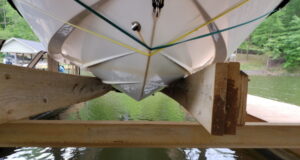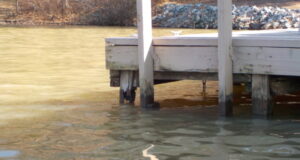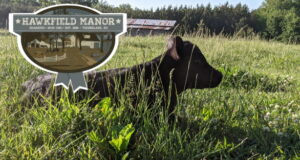Though the end of the gardening season can be bittersweet, I love winter gardening for many reasons. It just feels right that the plant world gets to take a rest. Sometimes, I think I can hear the trees, shrubs and perennials breathe a collective sigh of relief that winter is here and they don’t have to work so hard. On the human side the cold, crisp air and no bugs make working outside really enjoyable.
Everyone is familiar with the term “green thumb” and at our garden center, I constantly hear, “I don’t have a green thumb.” However, I believe that the secret to gardening success, a.k.a. “green thumb,” really boils down to two things: a “green brain” and a “green back.” By “green brain,” I am referring to putting some thought (brain) into your planting whether it be trees, shrubs, flowers, or your lawn. By “green back”, I mean putting effort (i.e., getting off your backside) into planting and caring for your landscape. In the first three articles of this series, we unpacked the green brain/green back approach by season: spring for planting the ornamentals (trees, shrubs and flowers), summer for vegetable gardening, and fall for seeding the lawn as well as planting trees and shrubs. In this last article of the series, we are going to look at how winter can be a great time to nurture your entire yard or landscape.
Lawn
Leaves, leaves, leaves. Get them up off the grass. They will kill the grass if left to sit there but can be beneficial in many other areas of the garden. Leaves are a wonderful source of organic matter. They contain beneficial trace minerals, and they are a good source of food for beneficial microbes and earthworms. Chipped leaves can be added to flower beds and used as a mulch for trees and shrubs.
If you haven’t already seeded, though it is getting late, it is better to plant grass seed now than in the spring. Lime is usually beneficial and can be applied anytime.
Trees and Shrubs
Winter is a great time to shore up the soil around trees and shrubs by adding organic matter such as leaves, or even just shaking out some bags of prepared soils such as composted chicken manure, mushroom compost, composted cow manure, gypsum, peat moss, or blended soils that contain elements of all of these. Your local garden center, like Abbott Farm Suppliers in Halifax, Va., should have these available.
Mulching is critical in the winter as temperatures can be unpredictable with swings causing the ground to freeze and thaw. This is hard on plants when the temperature swings are extreme. However, the ground/earth is a great insulator, so soil temperature does not fluctuate like air temperature. Mulching goes a long way to protect roots and provide insulation. One thing to keep in mind about mulching is to cover the roots and area around the plant, but try not to smother the trunk. Pull the mulch away from the base about an inch or two.
Pruning
Winter is a great time to prune because you can get a better look at the form and structure of the limbs and branches when they are bare of leaves. Pruning basics:
- To control size, a good rule of thumb is not to prune more than about one-third of the tree or shrub at one time.
- Prune dead limbs and branches.
- Prune limbs/branches that are crossed or rubbing against each other.
- Prune limbs/branches that just look odd or out of place based on the natural shape of the tree/
Winter is a great time to prune evergreens such as hollies and conifers, again using the one-third guideline. Do NOT prune azaleas in winter as that will affect spring blooming.
Insect Control
Insects are not usually out and buzzing around in the winter, but they are often hibernating or just not active to the eye. Winter is a great time to get ahead of spring and summer insect control by using something called “Dormant Spray,” often referred to as dormant oil spray. There are some application rules for dormant spray, so if you are unsure about when and how to apply, get advice from a reputable garden center.
Watering and Moisture Management
When it is freezing cold outside, watering trees and shrubs is not usually top of mind. However, water is critical in the winter, especially for evergreens if there is not sufficient rainfall or snow. Three winters ago, quite a bit of plant material was lost because it had been a very dry fall and early winter, and we saw temperatures in the low to high teens for almost three weeks. Even plants that drop their leaves (deciduous) still have root growth and dry, cold weather is especially hard on evergreens such as conifers, hollies, azaleas, boxwoods, magnolias, etc. They are still transpiring through their leaves and need water. Water is a wonderful root insulator and helps protect them from damage.
Though winter can seem to drag on forever in January and February when it is cold and gloomy, it is a great time to reconnect with the bare bones of your garden. Feed the birds, water your trees and shrubs, beef up your soil, and give your lawn and garden a huge head start for spring.
PO Box 134
445 S. Main Street
Halifax, VA 24558
(434) 476-7333
www.AbbottsInc.com
darnellabbott@abbottsinc.com
Follow us on Facebook and Instagram for advice and how to’s and Happy Fall Y’all!
![]()
![]()
![]()
Darnell Abbot is the Managing Partner of Abbott Farm Suppliers – Abbott Farm, Garden and Gun, a family-owned store since 1980, specializing in the well-rounded outdoor lifestyle.
Click here to read more stories by Darnell!
 Happy Endings Publications Hyco Lake, River City Area & SoBo Halifax Magazines
Happy Endings Publications Hyco Lake, River City Area & SoBo Halifax Magazines











